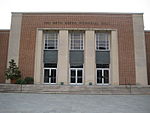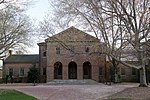Crim Dell bridge
1966 establishments in VirginiaBridges completed in 1966Buildings and structures in Williamsburg, VirginiaCollege of William & MaryPedestrian bridges in Virginia ... and 1 more
Wooden bridges in Virginia

The Crim Dell bridge is a wooden bridge on the College of William & Mary’s campus in Williamsburg, Virginia, United States and is considered one of the College's most scenic areas. Crim Dell itself is actually the pond that the bridge crosses over, but the bridge is commonly referred to as Crim Dell.
Excerpt from the Wikipedia article Crim Dell bridge (License: CC BY-SA 3.0, Authors, Images).Crim Dell bridge
Crim Dell Bridge, Williamsburg
Geographical coordinates (GPS) Address External links Nearby Places Show on map
Geographical coordinates (GPS)
| Latitude | Longitude |
|---|---|
| N 37.270625 ° | E -76.71349 ° |
Address
Crim Dell Bridge
Crim Dell Bridge
23185 Williamsburg
Virginia, United States
Open on Google Maps










